©
2004 Jeff Matthews & napoli.com
Haunted
houses
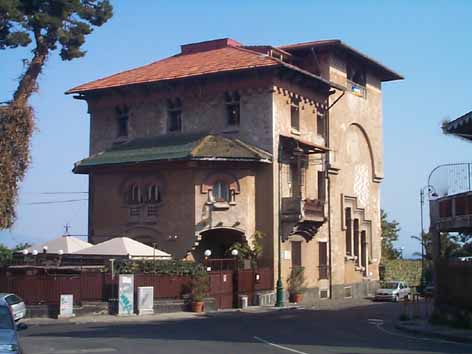 Speaking of places in Naples—yesterday's reference
to Gaiola—that are said to be haunted, there are at least two
so-called "haunted houses" in the city, buildings where terrible things
are known to have happened, and, no doubt, other terrible things that
are said to have happened never did but probably will if you get too
close. Speaking of places in Naples—yesterday's reference
to Gaiola—that are said to be haunted, there are at least two
so-called "haunted houses" in the city, buildings where terrible things
are known to have happened, and, no doubt, other terrible things that
are said to have happened never did but probably will if you get too
close.
One is
at via Tasso 615 (photo, left), at the very top of the hill (about
500 feet above sea-level) where that road then swings left out to the
long drive along the Posillipo ridge or turns right for the main road
into the Vomero section of Naples. According to a sign near the high
metal scroll gate, the building is called the Corte dei Leoni ("Court
of the Lions"). The villa is about as set–off as it could be in
an overbuilt city; that is, though one side of the villa is across the
street from the standard markets and cracker-box buildings of the 1950s,
the other side is right at the top of a steep slope with nothing in
the way to obstruct a spectacular view of Vesuvius and the Bay of Naples.
The Corte
dei Leoni is not typical architecture for Naples. It is a three-story,
irregular but roughly rectangular pseudo-Renaissance building. It has
the arched windows with prominent keystones and columns on either side,
and a pale-red brick façade with enough protruding bricks to
give it a softened ashlar effect. Placed high up on the façade
in various places are a few graven symbols. Two that stand out are on
either side of a large window. They appear to be some version or other
of the winged caduceus, the staff carried in Roman mythology by Mercury.
The wings are there, to be sure, but on top of each staff is a stylized
horse's—or dragon's—head. They face inward and "look at"
each other across the arch of the window.
The roof,
in Renaissance fashion, slopes gently down to all sides. As the villa
is actually built on a slope, that part of the building that faces the
sea has an additional story using the extra space provided by the rapid
change in elevation from the front of the property to the back. There
is dark or stained glass in most of the windows. On the seaward side,
there is a remarkable spiral stairway that winds the height of the building;
it is on the inside, but encased in glass and very visible from the
outside. The entire property is protected from the street by a high
iron fence webbed with ivy, such that it is impossible to look into
the grounds. There is a stone plaque embedded in the façade that
reads 1922 in Roman numerals, but the stone is weathered enough to look
much older than that. On the sea-side there is also a balcony. The whole
effect is Renaissance, yes, but so foreboding that if Juliet, herself,
were to walk out on that balcony and call down to me, "What satisfaction
canst thou have tonight?" I would leave.
The only
other information provided by a small notice board near the gate is
that the premises are available for wedding receptions, banquets—that
sort of thing. I don't think they get many takers, because everyone
in Naples "knows" it is haunted. I have been unable to trace the source
of the superstition. The one terrible thing that has happened there
in my memory was just a few years ago. A woman was walking by the house
early on a Sunday morning. Except for her, the street was apparently
deserted, for there were no eye–witnesses. The scene, itself,
provided the details: there is a large tree on the grounds and, as she
walked by, a high branch hanging over the fence and above the street
chose that moment to snap and fall, striking the woman in the head and
killing her. That sent "I-told-you-so" headlines shivvering across the
newspapers for a few day.
The other
"haunted" building is the Palazzo of the Prince of Sansevero located
at Piazza San Domenico Maggiore. (You can read about that building
by clicking here and about the
Prince of Sansevero, renowned as a sorcerer, by clicking here.)
Gestures,
hand (3); luck (good & bad) (2)
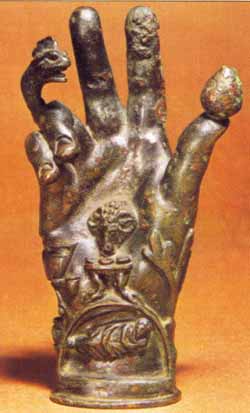 I
once spilled wine on a woman seated next to me at a dinner in Naples.
I apologized—and she laughed and thanked me! I later found out
that spilling wine on people is said to bring good fortune. I subsequently
went on a major campaign to spill as much wine as possible on as many
beautiful women as possible, all the while wondering why I was never
really “getting lucky”. It turns out that the good luck
accrues to the spill-EE, not the spill-ER. Tricky business, this luck
stuff. I
once spilled wine on a woman seated next to me at a dinner in Naples.
I apologized—and she laughed and thanked me! I later found out
that spilling wine on people is said to bring good fortune. I subsequently
went on a major campaign to spill as much wine as possible on as many
beautiful women as possible, all the while wondering why I was never
really “getting lucky”. It turns out that the good luck
accrues to the spill-EE, not the spill-ER. Tricky business, this luck
stuff.
Predicting
your fortune from wine—or oenomancy, as it is known to
real winos—has a long history. Even way back in the caves, you
know, you spilled a little vino on your loin cloth and, hey, don't worry
about it— "spilling wine brings good luck," they would say. Maybe
a little symbolism in there: grapes, liquid, harvest, fertility. Besides,
homo sapiens fermantatis had good reason to spill wine. He was
drunk. I don't understand it, but I respect it. I mean, if you can paint
those beautiful bison on limestone walls at Lascaux, you were obviously
assembled correctly.
In Naples,
there is also a well–known gesture to keep bad luck away: the
sign of the "corna"—the horns, made with the extended index
and little finger and waggling that sign towards the ground (as if you
were rooting for the U. of Texas upside–down). This will ward
off the Evil Eye. Also, touching the hump of a male hunchback is good
luck. Now, if you tell me all that, I may not agree with what you say,
but until the going gets rough I'll defend your right to say it. It
has just that plausible mixture of the Primeval and the Light vs Dark—what
my fruit vendor has termed "the Manichaean dichotomy, the Antinomial
on the brink of the abyss." (This could be what has been wrong with
his nectarines, lately, too). But it might be true. And as Pascal wagered
(roughly, but really): "Gee, you never can tell, so you might as well
believe." Is that gutsy, or what? Thus Spake Zaramilquetoast.
But the
one thing that tells me just how lucky I am and am ever going to remain
if I keep living on my street is this: If you step in dog-poop, Neapolitans
will tell you, "Don't worry. It brings good luck." That's right—Stepping…in…feces…brings…
good… luck! (I know this is delicate, so you may wish to go
read something about the history of the Khmer Rouge.)
I've heard
of Easy Street, the Street of Dreams, and The Street Where You Live,
but if this morsel of folk wisdom is true, then in terms of the ability
to confer happiness, all of these thoroughfares are squalid back-alleys
and blighted dead-ends compared to My Street. If stepping in the Sirius
Stuff is lucky, then My Street is an eight–lane toll–free
Expressway to human felicity.
The Voo–doo
Doo–doo Institute for Demographic Studies has shown that residents
of My Street have a higher income, live three–and–one–half
years longer than the national average, and are very noisy. Research,
however, has not shed any light on the origins of the belief that any
of this has to do with you know what. Sceptics, of course, claim that
attributing good fortune to conditions over which one has no control
is understandable, a kind of safety valve for the psyche, a de-stressing
little smile in the face of the great Existential Maw which sooner or
later devours us all. This, of course, is ludicrous and maybe even wrong.
It's the doggie-doo that does it.
Some time
ago, the City Parenting Persons put a Curb Your Dog sand-box down at
the corner on My Street. Man's Best Friend, of course, wouldn't go near
it. Nosiree, Spot. You stop leaving little patties of good luck—those
pulchritudinous tugboat-sized fortune cookies—in the right places
and pretty soon you're getting kicked around and blamed for broken
legs and missed lottery numbers. No way. I may be a damned dog, but
I ain't that dumb.
Carnevale
(1)
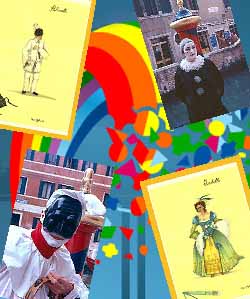 Today
is Mardi Gras. I was made aware of that yesterday when I noticed a couple
of very young children parading around in pirate costumes in the middle
of Piazza Plebiscito yesterday. It is
strange that in a city that has taken to foreign celebrations such as
Halloween, they don't go in much for a traditional Catholic holiday,
here. (There are, however, smaller towns near Naples that have traditional
festivities for carnevale, such as Avellino and Capua.) Today
is Mardi Gras. I was made aware of that yesterday when I noticed a couple
of very young children parading around in pirate costumes in the middle
of Piazza Plebiscito yesterday. It is
strange that in a city that has taken to foreign celebrations such as
Halloween, they don't go in much for a traditional Catholic holiday,
here. (There are, however, smaller towns near Naples that have traditional
festivities for carnevale, such as Avellino and Capua.)
The only
two cities in Italy with extravagant Rio–or New Orleans–like
activities for carnevale are Viareggio—on the western coast
of Italy as you move up the Ligurian coast past Livorno (quaintly known
in English as "Leghorn") on the way to Genoa—and, of course, Venice.
The only festival of that nature in Naples, I think, is the Festival
of Piedigrotta on Sept. 8 and 9. I say is, though used to be would be
more like it. I don't recall ever seeing anything more than a perfunctory
fireworks display, a far cry from the mile-long parade of floats, bands
and outlandish bedizenment wending its way along the seaside public
gardens to the Church of Piedigrotta years—decades—ago.
The city keeps promising to revive it. Who knows. So, today, there were
a few city-sponsored festivities around town, but nothing much.
My single
experience with the Carnival of Venice (besides listening to Rafael
Mendez' splendid trumpet solo on the piece of the same name!) was a
number of years ago. It was freezing and there was much too much over–amplified
music pumped into the crowd by crazed DJs from a local Rock station.
A friend wanted to go and visit the tomb of Igor Stravinsky located
on the cemetery island of San Michele in the lagoon. There, while he
was moping over the tomb of the maestro, I walked around and found a
remarkable inscription on a tomb from 1888, which said, in essence,
this:
| Rest
in Peace, my Little Boy
We
wished for you intensely, my beloved Nina and I. We had no son,
but you were born lifeless, and your dear mother died, as well,
giving birth to you, leaving me with five tender little girls.
|
I remember
being struck by the enormity of it: this poor women had died trying
to make up for her "failures" in producing nothing but girls. Her husband
just had to have a son.
It also
reminded me of when I got married and moved to Naples. A young woman
from a small town near Naples found out I was newly wed and said to
me, "auguri e figli maschi"—"best wishes and male children". She
was sincere, but it was one of those phrases that is well-rehearsed
through practice, the traditional thing to say to newly-weds. Today,
it has an olden ring to it, or at least it embodies the values of small
southern towns, one of which values is (or was) the large family—preferably
with a lot of strong male hands for farming. Having said that, it seems
to me that whenever I pass through one of those places, I see an awful
lot of women out working in the fields, or balancing heavy bundles on
their heads as they walk along the roadside, or leading animals to pasture,
so I'm not sure what all those strong male hands actually do. Maybe
they're for wielding the traditional lupara—shotgun—though,
again, I imagine women can be pretty good at that, too.
Young,
Lamont (2)
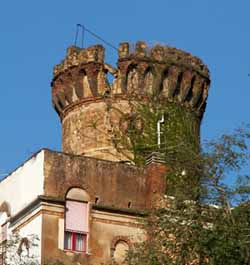 Lamont
Young's "castle" is going to be restored. It is a quaint piece of Victorian
Gothic architecture set on the cliff of Pizzofalcone, the original
cliff of Naples that overlooks the Castel dell'Ovo and the small harbor of Santa Lucia.
When it was built in the early years of the 20th–century, it really
did overlook all that; however, subsequent construction along the seaside
road over the course of the rest of the century has led to the pitiful
sight of a "castle" from which there is with no view at all except of
the splendid backs of the 4–and–5–star hotels now
directly in front of—and considerably higher than—the
cliff. Lamont
Young's "castle" is going to be restored. It is a quaint piece of Victorian
Gothic architecture set on the cliff of Pizzofalcone, the original
cliff of Naples that overlooks the Castel dell'Ovo and the small harbor of Santa Lucia.
When it was built in the early years of the 20th–century, it really
did overlook all that; however, subsequent construction along the seaside
road over the course of the rest of the century has led to the pitiful
sight of a "castle" from which there is with no view at all except of
the splendid backs of the 4–and–5–star hotels now
directly in front of—and considerably higher than—the
cliff.
The castle
was one of three or four such buildings put up by Young along the same
unusual lines, highly criticized at the time as being not in keeping
with the traditions of Neapolitan architecture. One of Young's other
castle-like Victorian Gothic structures in another part of town even
features an artificial crack (photo) high up on one of the towers, meant
to simulate great age or, perhaps, a lightning strike. All of these
buildings would be at home on the covers of gloomy novels about moors,
fog and frail heroines.
The buildings
are, however, charming, and the one on Pizzofalcone is now going to
get one–and–a–half–million euros to undo the
damage down by arson a few years ago; in addition, part of the grounds
will be converted to a museum/exposition room that will inform visitors
about this fascinating Neapolitan with the very English name. Here they
will learn about Young's plan for the total rebuilding of the city (including
the construction of an underground train line!) in the 1890s (a plan
that lost out to the Risanamento—the gutting of large sections
of the city).
[See
here for more on the life and work of Lamont Young.]
Portici
| This
ornate porcellan drawing room was designed by Giuseppe and Stefano
Gricci and Luigi Restile. It was completed in 1757 within the Royal
Palace at Portici. It was transferred to the National Galleries
at Capodimonte in 1866. There is a separate item on Capodimonte
here. |
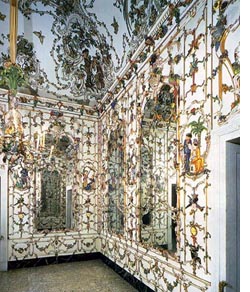 I
remember sailin across the Bay of Naples many years ago and noticing
a broad swath of green on the south slope of Vesuvius. This wooded area
spread inland almost from the sea to a spot a good distance up the slope
and was separated at the midpoint by a building so large that some of
the details of the architecture stood out even to an observer out at
sea. The greenery lay isolated in the midst of what is now the most
densely populated area in western Europe, surrounded on both sides by
chaotic urban sprawl. I
remember sailin across the Bay of Naples many years ago and noticing
a broad swath of green on the south slope of Vesuvius. This wooded area
spread inland almost from the sea to a spot a good distance up the slope
and was separated at the midpoint by a building so large that some of
the details of the architecture stood out even to an observer out at
sea. The greenery lay isolated in the midst of what is now the most
densely populated area in western Europe, surrounded on both sides by
chaotic urban sprawl.
Subsequently
I learned that the property was the old Bourbon Royal Palace and grounds
at Portici, built in the 1730s and 40s at the behest of Charles III, recently arrived from Spain to run the
newly independent Kingdom of Naples. It is one of four Bourbon Palaces,
all from roughly the same period. The other three are the Royal
Palace in downtown Naples, the Palace on the Capodimonte
hill, and the great Palace in Caserta, the so-called "Versailles of
Italy". In the course of more than two centuries, the Palace at Portici
has served, obviously, as a royal residence, but also as an archaeological
museum for artefacts from nearby Pompei and Herculaneum. Also, in 1839,
it had the distinction of being one terminus of Italy's first railway,
a track that started in town and wended its way out to Portici largely
for the purposes of making it easier for the royal family to "get away
from it all".
For most
of the 20th–century, the premises housed the Agricultural Department
of the University of Naples, which accounts for the abundance of the
greenery I noticed from a distance. There is a wide variety of vegetation
on the grounds, much of it from elsewhere in the world, all neatly labelled
and available for study. The Palace, itself, is remarkable. I was there
in the 1980s when they tore up some of the flooring to inspect the integrity
of the large tree-trunks that served as beams that cross-braced the
entire building and held the floors in place. After two centuries, they
were still solid and very little of the structure had to be reinforced.
(Given the denuded look of the area after centuries of chopping down
trees, I found it hard to believe—and I still find it hard to
believe—that those tree trunks originally came from around here,
but that's what they tell me.)
There is
now a plan to move the Agricultural Department out of the Palace to
another facility nearby and to convert the Palace to a museum focusing
on the archaeological and geological features of the area, which are
considerable: Pompei, Herculaneum, and Mt. Vesuvius. The university
will still have access to some of the building for classes and, of course,
will continue to use the large garden—a forest, really. The 20
million euros allocated for the restoration will go into removing the
signs of decades of use by the university, including chemical traces
from laboratories; then, the trappings and furnishings of the original
18th–century building will be restored. The project is expected
to take three years.
Troisi,
Massimo
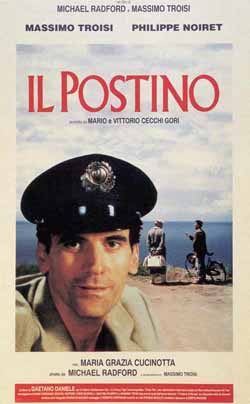 I
suppose it is futile—but understandable—to speculate how
the career might have turned out of one who died much too young. The
Neapolitan papers this week spent some time doing that, true, but, generally,
just paid heartfelt tribute to Massimo Troisi, from San Giorgio (near
Naples), who died in 1994 but who, this week, would have turned 50. I
suppose it is futile—but understandable—to speculate how
the career might have turned out of one who died much too young. The
Neapolitan papers this week spent some time doing that, true, but, generally,
just paid heartfelt tribute to Massimo Troisi, from San Giorgio (near
Naples), who died in 1994 but who, this week, would have turned 50.
Troisi
made his first film, in 1981, Ricominciamo da tre (a pun on the
expression Ricominciamo da zero—Let's Begin at Zero (the
beginning)—thus, Let's Start at Three, and his last film, shortly
before his death, Il Postino (The Postman—probably his
best-known film abroad). Perhaps only Roberto Benigni, among recent
Italian comics, strikes you the same way Troisi does—as having
that quality of comic genius worthy of mentioning in the same breath
as the great Totò. (Benigni and Troisi appear in one film
together, in 1984: Non ci resta che piangere (There's nothing
left to do but cry) where they are transported in time back to the 1400s
and even meet Leonardo da Vinci and give him some pointers.)
Troisi
already generates the same type of "Do you remember that episode…?"–stories
that characterize conversations about all great comics. (Do you remember
that scene of Laurel and Hardy moving the piano up the long flight of
steps? Of course you do.) There are scores of those about Totò
and, by now, a lot of them about Troisi. Yes, I remember that scene
where Troisi plays the wrong Mary (!), not the mother of Jesus,
but another Mary in "a city of Galilee named Nazareth" whose daily routine
gets interrupted by an inept Herald Angel who keeps barging onto the
stage with "Hearken! Mary…the Lord is with thee…thou shalt
conceive…" Troisi spends the skit trying to convince the angel
that he has come to the wrong house and the wrong Mary. Joseph's wife
is over on the next street. There is not the least sense of irreverence
in the performance, either, and I am sure the Pope thinks it's a riot!
Troisi's
language was that of Naples, with virtually no attempt to modify his
difficult native dialect to a more standard Italian for the benefit
of those who might have difficulty understanding him—audiences
in northern Italy, for example. With Totò, Troisi is a living
language lesson and one more reason why almost all Italians now like
to think they speak a little Neapolitan.
Ischia
A
Donkey Serenade
Being a Recounting of Marvelous and Intrepid Adventures on Remotest
Ischia.
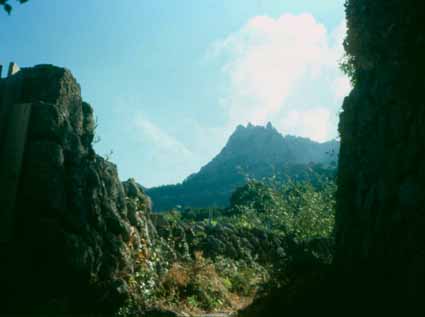 We all have shreds of strangeness scattered through
our lives, giving a special dreamlike quality to the most fortunate
of our memories. One of mine was discovering Antonio Gaudi, the magical
Catalonian architect, whose cathedral stands in Barcelona—a psychedelic
stalagmite of parabolas, saddle-like curves and weird geometries from
another dimension dripping down like wet sand through the fingers of
a playful giant. We all have shreds of strangeness scattered through
our lives, giving a special dreamlike quality to the most fortunate
of our memories. One of mine was discovering Antonio Gaudi, the magical
Catalonian architect, whose cathedral stands in Barcelona—a psychedelic
stalagmite of parabolas, saddle-like curves and weird geometries from
another dimension dripping down like wet sand through the fingers of
a playful giant.
I added
another tatter a few weeks ago on Ischia. I had just finished ploughing
through an imposing German tome on the island. It was full of footnotes
and umlauts. In fact, you are almost reading about the late Stone Age,
the Bronze Age, Pithecusa (the original Greek name for the island) and
how the Greeks found in Ischia's Mt. Epomeo another Olympus, another
safe hiding place for their Gods. Then came the Romans, the Paleochristians,
the Aragonese and the Saracens. So, be glad I found Viola, a lovely
brown donkey mare, who took me up the slopes of Epomeo, where the spirit
of Gaudi dwells.
After making
the long storm-tossed crossing from Neapolis and quelling a native uprising
at my hotel, I betook me to the quaint outpost of Fontana, the most
convenient "base camp" from whence to begin the climb up the 800-meter
high mountain. It was then that I saw Viola—beautiful brown eyes,
long lashes, even longer ears, and a mane stroked by, alas, who knows
how many coarse hands. She was standing in the main square in Fontana,
reluctantly looking for passengers. She looked like Rocinante hoping
against hope that Don Quixote had wandered away and would never come
back.
"Oh, a
donkey," I exclaimed, a veritable Julian Huxley finally seeing his way
through to some great biological truth.
"You are,
indeed, most perceptive, bwana-sahib," croaked the wizened Chargé
du Donkeé. He genuflected in the traditional fashion of his ancestors,
touching first his forehead, then his heart, then my wallet. "She will
take you right to the top for a mere trifle."
"Hmmm,
that's not even a pittance a pound. Not bad. But, am I not too stout—all
solid muscle, of course—but a bit too hefty for this delicate
steed?"
"Not to
worry, O wise one, for it is written that this is the life they are
born to."
Viola,
naturally, had heard this Bible-thumping, fundamentalist interpretation
of Genesis 1:26 many times before and she was not amused. But, with
that floppy-lipped snort that donkeys emit when they dream of their
great stallion cousins flashing like Pegasus free and unshod across
Arabian dunes, she acquiesced. I climbed aboard and we went straight
up, first on a paved road and then the last two-hundred yards or so
along a precise trail, partially hewn out of the rock, but mostly just
plain worn down by the methodical sculpting of countless plodding hooves.
The summit
of Epomeo is a castle carved out of rock. There is no building; all
the chambers in the one-time home to an order of Franciscan monks are
in the rock. Again, Gaudi's giant friend must have poked his fingers
into the lava when it was still warm and pliant, yet firm enough to
hold impressions which an age later would become the chapel, dining
hall and cells for the monastery of San Nicola.
If you
go when there is a mist blowing up the slopes, the jagged rock that
forms a watchtower on the summit tears at the stream of whiteness swirling
by. It sticks up like a cockeyed crown on a ghostly head calling you
into a fairy-tale, and if you are in the fanciful mood that accepts
fairy-tales, then that will be your "strange" moment, the one you remember.
That and
the sunrise, because sadly for the monks but happily for you, this mountain
retreat is now an inn. You can ride or walk up in the evening and stay
in one of the cells. (It's not as bleak as it sounds; each cell
has a balcony with a breathtaking view, the beds are clean, and when
you run out of gruel, you can go to the restaurant). From the watchtower
and various points around the summit, there is a stunning view straight
out over the island and the gulf to Vesuvius and the Sorrentine Peninsula.
Here, it is pardonable to believe in the illusory astronomy that the
Earth is the center of all things, as the sun paces the passage of eternity,
slowly shifting, sunrise by sunrise, inexorably along the rim
of the mountains and back again. On Ischia, "to watch the dawn from
Epomeo" is a metaphor of splendour—to be up there in monastic
stillness watching the sun perform its timeless rites and to feel that
you are the first ever to behold the transformation of night into day.
"Neptune"
fountain
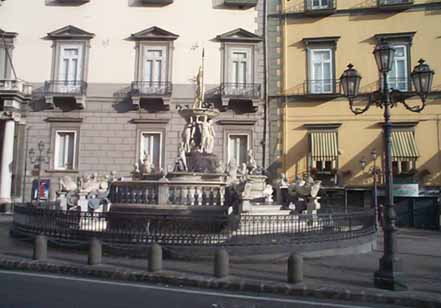 I have difficulty believing that they are going to move
"Neptune" again. I was down there today looking at it, and in my non-expert
opinion of where fountains belong and how they fit in and why they should
not be disassembled, moved and put back together every few years, it
looks fine. True, they pinched off one traffic lane a bit in order to
install the fountain, but they opened up the pedestrian area around
the immediate area, and have put in benches and a tourist information
bulletin board. The fountain is now on via Medina, adjacent to Piazza
Municipio. I have difficulty believing that they are going to move
"Neptune" again. I was down there today looking at it, and in my non-expert
opinion of where fountains belong and how they fit in and why they should
not be disassembled, moved and put back together every few years, it
looks fine. True, they pinched off one traffic lane a bit in order to
install the fountain, but they opened up the pedestrian area around
the immediate area, and have put in benches and a tourist information
bulletin board. The fountain is now on via Medina, adjacent to Piazza
Municipio.
There are
very few pieces of sculpture that have traveled as much as this one.
This fountain started out down by the Arsenal --at the port-- when it
was built in the 1500s. It was built on the order of Enrico de Guzman,
the Spanish viceroy at the time and was situated so that it faced his
residence. The design is by Giovanni da Nola; Neptune (the centerpiece)
and the two satyrs are by Pietro Bernini.
In 1629,
it was moved up to Largo Palazzo, now called Piazza Plebiscito on the order of the viceroy, Alvarez
de Toledo. Then, in 1634, it was moved down to the sea at Santa Lucia
after being touched up by Cosima Fanzago. There, it was in such danger
of being exposed to artillery fire that it was moved up to via Medina,
more or less where it is today. In 1647 it was repaired after being
damaged in the uprisings of that year; bits and pieces taken away
as souvenirs to Spain by the viceroy also had to be redone. In 1659,
it was moved again, this time to Calata San Marco, about two
blocks from its current location. In 1700 it was moved back to via Medina
to be nearer to the main road leading down to the port. At that time,
sea horses and tritons were added to the statue. In 1898 it was moved
to Piazza Borsa (the Stock Exchange) and, thus, was located at
the beginning of Corso Umberto, the broad boulevard leading to the main train station.
That square is currently the site of construction for the new Naples
Metro underground train line, so in 2001 the statue was moved back to
via Medina where it was in 1640.
The statue's
current location is described as "temporary," and it is to be returned
to Piazza Borsa when they finish the metro station in that square.
I hope they leave it where it is.
Carnevale
(2)
 I
see in the papers that 55.000 people have showed up in Venice
for the beginning of carnevale, a celebration that will run through
next Tuesday, Mardi Gras. I
see in the papers that 55.000 people have showed up in Venice
for the beginning of carnevale, a celebration that will run through
next Tuesday, Mardi Gras.
How can
this be?—I ask myself. Did I not identify last Tuesday, Febraury
18, as Mardi Gras on the basis of seeing two young children parading
around in pirate costumes? Indeed. There must be some mistake. Perhaps
I was thinking in a different calendar. The Coptic Christian calendar,
perhaps? That might be a way out, I think. I don't know, however, that
there are many Copts in Naples. On the other hand, I do often walk by
a small private club called the "Circolo Mare Rosso" (The Red
Sea Club). Beneath that inscription is the equivalent name, written
in a very strange alphabet that seems to be full of pitchforks and dyslexic
versions of the letter J. Yes! That must be Coptic, the end-stage of
ancient Egyptian, and now the liturgical language of a strong minority
of Christians in Egypt, an overwhelmingly Moslem nation. I have somehow—just
by walking by the place—picked up on their early celebration of
the week before the beginning of Lent. I rush down to check it out.
Oops. The sign proves to be in the Amharic language, written in what
is called Ethiopian script, a derivation of the old Arabic alphabet.
It really looks nothing like the Coptic script, I have to admit.
Hmmm. Maybe
I was thinking in the Neapolitan Revolutionary calendar, from way back
in 1799 when Neapolitan revolutionaries redid the entire calendar
after the fashion of Revolutionary France: January was called "Rainy".
I think February was called "Foggy". I am not sure of that one, but
the potential for confusion with the Seven Dwarfs is obvious and certainly
could have been no source of strength to the Republic. Besides, they
were anti-clerical, so I don't suppose reactionary Christian holidays
were even recognized in the calendar. That, too, is out.
It can't
be the Greek Orthodox calendar, because I don't know anything about
that one, except that it uses the Julian Calendar instead of the
Gregorian Calendar to calculate Easter, and, after dividing the vernal
equinox by pi, they are bound to be a week or two off, just like me.
I may just have to step up and forthrightly take responsibility for
myself and blame my miscalculation all on those little Revolutionary
Orthodox Coptic kids running around Piazza Plebiscito last week.
[In spite
of all that, the Greek Orthodox faith has an interesting history in
Naples. Click here.]
Mercato,
Piazza (1); City walls;
Carmine church and castle; Porta Capuana
If by "city
walls" you mean the ancient Greek or Roman ones that surrounded Neapolis,
there is nothing left of those above ground in modern Naples. There
are, however, some fragments that have been excavated and left open
for viewing; the most prominent one is the section of the Greek wall
visible at Piazza Bellini. The rest has
disappeared under—in some cases—natural catastrophe, such
as mudslides (a prominent one occurred in the sixth century), or was
simply torn down or built over in the typically palimpsest approach
to urban planning that has characterized Naples in its long history.
The medieval
walls are a different story. Starting with the Angevins in the 14th–century
and continuing well into the Spanish and even Bourbon periods in Naples,
the protective wall around Naples was constantly under some phase of
construction and renewal. It is in the late 19th– and early 20th–century,
during the great Risanamento—the
urban renewal—of the city, that that changed. Massive portions
of the medieval walls were torn down; yet, some were left standing as
historical markers, and segments of the wall were simply incorporated
into modern buildings.
 The most obvious historical marker is the part of wall
and the pillars at what used to be the south-east corner of the city
wall across from Piazza Mercato and the Church of the Carmine
(see below). There is not much left of this castle, and the ruins
you see here are often referred to simply as "part of the old wall down
by the port". In reality, this is what remains of the Castello del
Carmine, now on the main road that runs east along the industrial
port of Naples. It was built by the Angevin ruler, Charles III
of Durazzo, in the 1380s. It was a true fortress and at the center of
battles during the Angevin and subsequent Aragonese
period. It was expanded, as well, under the Spanish in the 1560s. It
was also one of the strongholds of conspirators during Masaniello's
revolt, which led to a very short-lived (5 days!) first "Neapolitan
Republic" in 1647. It played a strategic role, as well, in later military
campaigns, namely the Neapolitan revolution of 1799 and the Bourbon
resistance to the army of Garibaldi in 1860. The pillars seen in the photo
are all that remain of the Carmine Gate, one of the main entrances into
the city along the south wall in the late Middle Ages. The structure
was demolished in the early 20th century to make room for road expansion
along the port. The most obvious historical marker is the part of wall
and the pillars at what used to be the south-east corner of the city
wall across from Piazza Mercato and the Church of the Carmine
(see below). There is not much left of this castle, and the ruins
you see here are often referred to simply as "part of the old wall down
by the port". In reality, this is what remains of the Castello del
Carmine, now on the main road that runs east along the industrial
port of Naples. It was built by the Angevin ruler, Charles III
of Durazzo, in the 1380s. It was a true fortress and at the center of
battles during the Angevin and subsequent Aragonese
period. It was expanded, as well, under the Spanish in the 1560s. It
was also one of the strongholds of conspirators during Masaniello's
revolt, which led to a very short-lived (5 days!) first "Neapolitan
Republic" in 1647. It played a strategic role, as well, in later military
campaigns, namely the Neapolitan revolution of 1799 and the Bourbon
resistance to the army of Garibaldi in 1860. The pillars seen in the photo
are all that remain of the Carmine Gate, one of the main entrances into
the city along the south wall in the late Middle Ages. The structure
was demolished in the early 20th century to make room for road expansion
along the port.
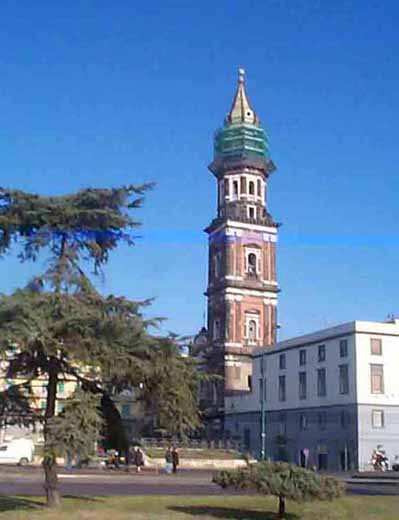 Directly across the street is Church of Santa Maria
del Carmine (photo, left) at one end of Piazza Mercato (Market
Square), one of the most historic sites in Naples. The church itself
was founded in the 12th century by Carmelite monks driven from the Holy
Land in the Crusades. The historic name of Piazza Mercato is
Piazza Moricino. It was the site in 1268 of the execution of
Corradino, the last Hohenstaufen pretender to the throne of the kingdom
of Naple, at the hands of Charles I of Anjou, thus beginning the important
Angevin reign of the kingdom. In 1647 the square was also the site of
battles between rebels and royal troops during Masaniello's Revolt,
and in 1799 the scene of the mass execution of leaders of the Neapolitan
Republic. Directly across the street is Church of Santa Maria
del Carmine (photo, left) at one end of Piazza Mercato (Market
Square), one of the most historic sites in Naples. The church itself
was founded in the 12th century by Carmelite monks driven from the Holy
Land in the Crusades. The historic name of Piazza Mercato is
Piazza Moricino. It was the site in 1268 of the execution of
Corradino, the last Hohenstaufen pretender to the throne of the kingdom
of Naple, at the hands of Charles I of Anjou, thus beginning the important
Angevin reign of the kingdom. In 1647 the square was also the site of
battles between rebels and royal troops during Masaniello's Revolt,
and in 1799 the scene of the mass execution of leaders of the Neapolitan
Republic.
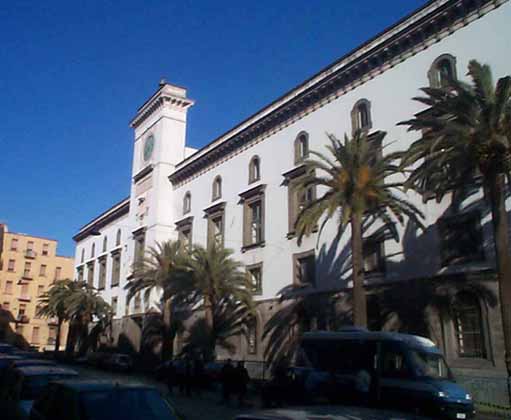
If
you walk north into the city from that point along what used to be the
line of the eastern wall of the medieval city, you will probably get
lost, but—after some judicious zigging and zagging—you will
eventually come to Porta Capuana and Castel Capuano (photo,
right) takes its name from the fact that it was at the point in the
city walls where the road led out to the city of Capua. The castle is
at the end of via dei Tribunali and today houses the Naples Hall of
Justice. It was built in the twelfth century by William I, the son of
Roger the Norman, the first monarch of the Kingdom
of Naples. It was expanded by the Holy Roman Emperor, Frederick
II of Swabia and became one of his royal palaces. Under the Spanish
viceroyship of Don Pedro de Toledo in the sixteenth century, it became
the Hall of Justice, the basements of which served as a prison. Over
the entrance to the castle you still see the crest of the Emperor Charles
V, who visited Naples in 1535. The castle has undergone many restorations,
one as recent as 1860, and thus no longer retains a great deal of its
original appearance.
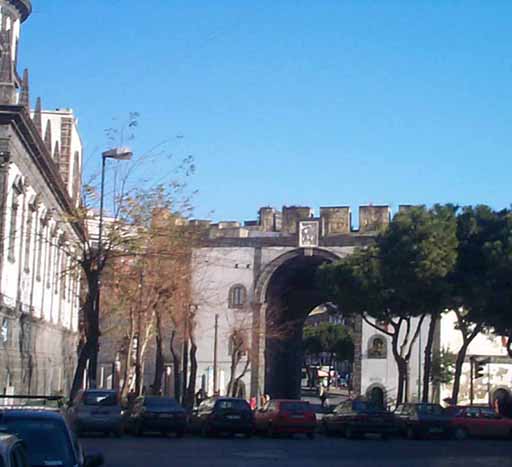
Porta Capuana (photo, left), in spite of the name, is not the ancient
gateway to the decumanus maximus, the main east-west road that
once led out of Roman Naples to Capua. When the city was extended eastwards,
the construction of the new Aragonese city
walls meant relocating the original gate, which had been closer
to the castle. The present gate was built in 1484. It is still there and
you can drive or walk through and around it.
The most
interesting examples of how the medieval walls have simply been incorporated
into more modern buildings occur if you keep moving along that same
line of the eastern wall to the point where it turned left to run along
the northern side of medieval Naples, along what is now via Foria. At
that corner is an enormous building now housing municipal office space
but with the inscription Caserma [barracks] Garibaldi
still prominent on the façade. That ex-barracks was the medieval
monastery of San Giovanni a Carbonara, which, itself, was built using
the corner formed by the meeting of the eastern and northern walls of
the city as two sides of the monastery and then building the rest behind
that barrier.
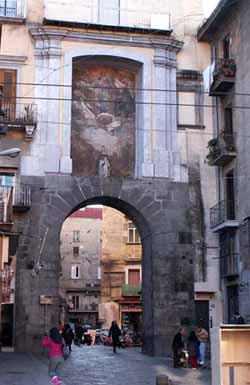 As
you walk west along via Foria, keeping an eye on the dense row of buildings
that now stand where the wall used to be, the most obvious thing is
that modern office and apartment buildings are not only much higher
than the original wall, but that—in the case of one high school—
as high as the original height of the Greek city, itself. The city sloped
dramatically upwards in that direction. Piazza Cavour and the Archaeological Museum (down at the far end of the
wall before it turned to form another corner and run back towards the
sea) are below the highest point in the city, where the Greeks put their
acropolis. That height is no longer evident because of the modern buildings
in front of the ancient cliff. However, many of the buildings along
via Foria have used part of the medieval wall at their base. Why waste
a good 100 feet of solid wall? Put in a few windows and doors,
and you've got yourself the first few floors of one side of a building.
The San Gennaro Gate (photo, left), of course, is in that section of
wall and is not only still open, but is still a main pedestrian path
in and out of the old city. As
you walk west along via Foria, keeping an eye on the dense row of buildings
that now stand where the wall used to be, the most obvious thing is
that modern office and apartment buildings are not only much higher
than the original wall, but that—in the case of one high school—
as high as the original height of the Greek city, itself. The city sloped
dramatically upwards in that direction. Piazza Cavour and the Archaeological Museum (down at the far end of the
wall before it turned to form another corner and run back towards the
sea) are below the highest point in the city, where the Greeks put their
acropolis. That height is no longer evident because of the modern buildings
in front of the ancient cliff. However, many of the buildings along
via Foria have used part of the medieval wall at their base. Why waste
a good 100 feet of solid wall? Put in a few windows and doors,
and you've got yourself the first few floors of one side of a building.
The San Gennaro Gate (photo, left), of course, is in that section of
wall and is not only still open, but is still a main pedestrian path
in and out of the old city.
The medieval
western wall of the city—which, itself, followed the line of the
ancient Roman wall— was simply knocked down by the Spanish in
the 1500s when they decided to expand the city beyond the ancient confines
and move up the hill towards the Sant' Elmo Fortress. The long straight
road, via Toledo, laid by the Spanish in that period is well outside
the ancient city. The Spanish moved Port'Alba, originally one of the
main gates in the medieval western wall of the city, a few hundred yards
to the west (where it remains today), such that it opened onto the new
Spanish section of the city. By that time, the old west wall no longer
served any defensive purpose and much of it went the way of all old
walls in Naples—torn down, ploughed under, built over, and, in
some cases, reincarnated as parts of newer buildings.
Airports—
Yes,
this photo really was taken at Capodichino airport in Naples shortly
after the Germans left the city in 1943. Photo courtesy of Herman Chanowitz.
|

I remember
when Naples Capodichino airport looked like an airfield in documentaries
about WW2 —maybe even WW1: windsocks on the runway and strange
little people in goggles and flying scarves running around mowing the
airstrip and hand-cranking Fokker triplanes. Well, maybe not all that,
but there were no newfangled accordion tubes that snuggled up to the
side of the planes for easy on–and–offloading of contented
passengers. There were no contented passengers. There were no
busses, either; you walked out onto the tarmac to your plane. Sometimes
they got your bags out there before you left; sometimes they didn't.
Indeed, it was a throwback to those glorious early days of aviation.
They still spelled it "aeroplane," as I recall.
Since the
reinvention of mass tourism in the Bay of Naples, that has changed.
The sign now says "Naples International Airport" and the place deserves
the appellation. The passenger terminal was more than simply expanded;
it was rebuilt. It is new, spacious, and comfortable with all the bars,
shops and other creature comforts that one expects while one waits.
There is also ample parking, one of the few places in Naples to enjoy
that comfort so necessary to 21st–century creatures.
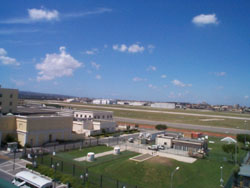 The
problem now is that no amount of expansion of the facilities (photo)
can handle the projected traffic. The paper this morning writes of the
grand plan to open up the military airport in nearby Grazzanise (about
35 miles from Naples near Capua) to passenger traffic. It was tried
once, out of necessity, some 15 years ago when the Capodichino airport
was partially closed for modifications. The plan, if it goes forward—and
that depends on complicated negotiations between the Italian air force
and various civilian agencies that have an interest in air traffic in
and out of Naples—is to route charter tourist traffic through
the new facility as early as this summer. Since much tourist traffic
is directed not to the city of Naples, itself, but to other areas of
the Bay such as Sorrento and the islands of Ischia and Capri, and since
the Grazzanise airport is near the A-1 autostada that runs into the
city, the plan might entail nothing more inconvenient than a slightly
longer bus ride for passengers, no matter what their destination. The
problem now is that no amount of expansion of the facilities (photo)
can handle the projected traffic. The paper this morning writes of the
grand plan to open up the military airport in nearby Grazzanise (about
35 miles from Naples near Capua) to passenger traffic. It was tried
once, out of necessity, some 15 years ago when the Capodichino airport
was partially closed for modifications. The plan, if it goes forward—and
that depends on complicated negotiations between the Italian air force
and various civilian agencies that have an interest in air traffic in
and out of Naples—is to route charter tourist traffic through
the new facility as early as this summer. Since much tourist traffic
is directed not to the city of Naples, itself, but to other areas of
the Bay such as Sorrento and the islands of Ischia and Capri, and since
the Grazzanise airport is near the A-1 autostada that runs into the
city, the plan might entail nothing more inconvenient than a slightly
longer bus ride for passengers, no matter what their destination.
Me, I have
a Fokker to crank.
Pizza
(1)
Sign
claims to mark the home of the first Margherita Pizza
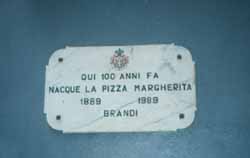 I once
had a "Taco Pizza" in Honolulu. If pizza were human language, a discussion
would now follow on Grimm's Law, how pizza changes over time, creolization
of pizza, dialects of pizza, and very, very irregular verbs. Fortunately,
it's just pizza. The greatest recent innovation in pizza in Naples,
recently, is the cyber-pizza. Yes, you can actually walk into a pizzeria
down at Santa Lucia and have a pizza con funghi (mushrooms) while
you check your email and browse. I once
had a "Taco Pizza" in Honolulu. If pizza were human language, a discussion
would now follow on Grimm's Law, how pizza changes over time, creolization
of pizza, dialects of pizza, and very, very irregular verbs. Fortunately,
it's just pizza. The greatest recent innovation in pizza in Naples,
recently, is the cyber-pizza. Yes, you can actually walk into a pizzeria
down at Santa Lucia and have a pizza con funghi (mushrooms) while
you check your email and browse.
Speaking
of which, I did come across this:
| Lévi-Strauss
explores the semiotic properties of culinary practices as a model
for social ideology [to] express complex transformations of social
category systems. His remarks about attitudes to mushrooms suggest
the importance of historical experience for the retention of symbolic
associations between edible forms and cosmological concepts.
"Culinary
Semiotics" in Encyclopedic Dictionary of Semiotics. 1986.
|
I immediately
think when I read this that this Lévi-Strauss is one pretty "sharp
cookie" (I am, as you see, no slouch at food symbolism, myself). I mean,
besides inventing Blue Jeans and composing the Blue Danube Waltz, he
still has time to "get his licks in" (touché!) in the food column
of his local encyclopedia of semiotics. His insight about mushrooms,
alone, is worth its weight in—well, mushrooms.
Mushrooms.
Think. You are putting on your pizza something that is not animal, vegetable
or mineral. They are alive, yes, but so was the thing that burst out
of that guy's chest in Alien. Mushrooms are mycetes, fungi, and
"they are classified as something else!" (That's just they way my dictionary
puts it, too—italics, exclamation mark and all. It even has 'jitter'
lines around the phrase, like those old horror-movie posters, to make
you think that the words, themselves, are slowly moving towards you,
stalking you—but why talk about celery at a time like this? The
dictionary then adds: "Believe us, you don't want to know any more.")
Mushrooms
live in the dark, reproduce by spores and are spitting images (yuk!)
of those things that toads sit on, and if you, with a brain the size
of a bowling ball, can't tell the difference, what makes you think toads
can? Furthermore, some languages, such as Italian and German, use the
same word for "mushroom" as they do for whatever that gunk is that grows
between your toes in the condition known as "athlete's foot". Think
about that "symbolic association between edible forms and cosmological
concepts" the next time you order pizza con funghi. Or, as we
food–semiotics say: "How do you like them apples?!"
I know
a Neapolitan woman who, for ideological reasons, refuses to eat any
other pizza but the "Margherita". It seems that that pizza was named
in the last century in Naples for the first queen of united Italy, Margherita
of Savoy (1851-1926), wife of Umberto I. When the royal family was in
Naples, they stayed, of course, at the ex-Bourbon Royal Palace. (Why
waste a good palace just because it belonged to a previous dynasty?)
A few blocks away from the palace, just off of Via Toledo (also known
as via Roma) is a ristorante cum pizzeria named Brandi
(photo above), one of the most historical of such establishments in
Naples. Among the many items of interest on the walls, next to all the
pictures of the rich, fat and famous who have eaten there, is the story
of how their chef concocted the first pizza Margherita for Her Royal
Highness and took it over to the palace, himself. (What was he going
to say—"We don't deliver." ?) The colors of the makings—green
(basil), white (mozzarella) and red (tomato)—stood for the national
colors of the new nation. (Right, whenever the flag was paraded by,
every pizza in Naples rose. It was the yeast they could do.) The socio-political
ramifications are, indeed, getting deeper and deeper here. Why, for
example, does one even put "Basil" on a pizza? After all, he was a Greek
prelate who lived from 330 to 379 a.d. and who was the Bishop of Caesarea.
Or mozzarella?
Something which comes from the udder of a buffalo?! Now, except for
that admittedly touching film about buffaloes that dance with wolves,
or whatever, what are the other associations you have for "buffalo"?
See what I mean?—"Buffalo Gals," "buffalo breath" and "buffalo
chips". I am too young to remember exactly–or even approximately–what
"Buffalo Gals" were (except that they apparently liked to "dance by
the light of the moon") but I do have, modestly, a passing familiarity
with the breath and the chips, and I say, "No, thank you."
And tomato?
Now that you have worked yourselves into a semiotic feeding frenzy,
you are no doubt asking yourselves why the archaic slang of detective
fiction refers to a beautiful woman as a "swell tomato", as in "Geez,
boss, dat sure wuz some swell tomato you wuz wit'," when it should be
clear even to those with marginal IQ's that the adjectival participle
of "swell" is "swollen". Ergo: "Geez, boss, dat sure wuz some swollen
tomato you wuz wit'." I did, however, see a "tomato" once with a "pair
of gazoombas that would stop your heart". The only reference I have
been able to find to "gazoomba" is in my English-Quechua dictionary.
It is an ancient Incan word for "mushroom".
Coppola,
Villaggio
 And
then there were five. I am talking about the infamous "Towers" along
the Flegrean coast, a long stretch of potentially beautiful beach at
Castel Volturno, just up the coast from Naples. Officially, the towers
were known as the Villaggio Coppola, built by the Fontana Blu Corporation,
owned by the Coppola bothers. And
then there were five. I am talking about the infamous "Towers" along
the Flegrean coast, a long stretch of potentially beautiful beach at
Castel Volturno, just up the coast from Naples. Officially, the towers
were known as the Villaggio Coppola, built by the Fontana Blu Corporation,
owned by the Coppola bothers.
The entire
complex included eight 15-story apartment houses (the "Towers"), adjacent
hotels, restaurants, a small boat harbor—an entire small city
and, collectively, one of the ugliest examples of illegal, "wildcat"
construction in Italy. Having said that, it is worth noting that they
were built largely to house members of the US military. That particular
need is no longer served since the US Navy now has its own satellite
city in nearby Gricignano—built on property owned by the Coppolas.
(Perhaps there is a book waiting to be written about the relationship
of the US government to the Brothers Coppola.) The towers, they say,
were an example of what you could get away with a few decades ago with
large envelopes of cash. ("Oh, what's that over there?" you would say,
pointing into the distance. Then, while the building commissioner was
distracted and staring off into space for two or three years, you—with
no building permit—put up your "ecomonsters," as the press calls
them.)
Over the
years, I have driven up past that stretch of coastline and have grown
accustomed to glancing over and seeing that row of ugly monolithic dominoes
on the beach—"Pukehenge," we used to call it. The were horribly
visible from a distance and perhaps even from low orbit. Yesterday,
I looked over and did a happy double-take. There was one missing. They
had blown it to smithereens while I wasn't looking. Today the newspaper
reports that at 3 pm another explosion will devour two more of them.
That will leave five, and they are scheduled for demolition in April.
It's almost worth the drive to watch.
|
